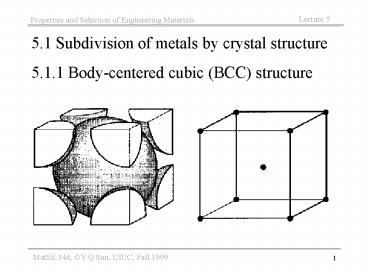Properties and Selection of Engineering Materials - PowerPoint PPT Presentation
1 / 23
Title:
Properties and Selection of Engineering Materials
Description:
MatSE 346, Y Q Sun, UIUC, Fall 1999. Properties and Selection of ... Nylons: textile, carpets, gears and bearing, degrades with moisture absorption ... – PowerPoint PPT presentation
Number of Views:2260
Avg rating:3.0/5.0
Title: Properties and Selection of Engineering Materials
1
5.1 Subdivision of metals by crystal
structure 5.1.1 Body-centered cubic (BCC)
structure
2
BCC metals and their major characteristics
- Metals
- Fe (low T), Ti (high T), Nb, Cr, V, Mo, W
- Common characteristics
- Less ductile (than FCC)
- Stronger (than FCC)
- high Tm, low work-hardening rate.
3
5.1.2. Hexagonal close packed (HCP)
4
HCP metals and their major characteristics
- Metals
- Mg, Zn,Be Cd, Ru Ti (low T), Zr (low T), Hf
(low T). - Common characteristics
- Less ductile than FCC and BCC metals
5
5.2. Polymorphism A solid material having more
than one structures.
- Fe
- FCC, T910 oC, ?-phase (Austenite)
- BCC, T
- Ti
- BCC, T882 oC, ?-phase
- HCP, T
- Co
- FCC, T390 oC
- HCP, T
6
5.3. Why crystal structures?
- A method to subdivide metals into subgroups.
- Different crystal structures correspond to
different properties. - A way of understanding materials consisting of
a mixture of different crystal structures (e.g.
Ti-6Al-4V, consisting of ? (HCP) and ? (BCC)
phases).
7
Example stainless steels
- Ferritic (BCC) stainless steels
- BCC like properties
- low ductility, hardenable by carbon atoms,
ferromagnetic - Austenitic (FCC) stainless steels
- FCC like properties
- high ductility, high work-hardening rate,
non-ferro magnetic
8
5.4. Phase
- Definition
- A phase is a physically and chemically
homogeneous portion of material. - Examples
- Water gaseous phase (vapor), liquid phase, solid
phase (ice). - Iron liquid phase (melt), ?-phase (FCC), ?-phase
(BCC).
9
Phase transition
- Change of material form one phase into another.
- The transformation can be induced by changes in
temperature, pressure, shear stress, electric and
magnetic field. - Phase change is described by phase diagrams
10
Phase diagram an example Ti-Al system
11
5.5 Common properties of metals
12
(No Transcript)
13
5.6 Subdivision of plastics by setting behavior
- All polymers are plastic (easy to flow) at one
stage of their fabrication - Thermoplastics can be repeatedly
softened/hardened by heating/cooling - Thermosets are set/cured/hardened permanently and
will not soften again.
14
Major thermoplastic polymers
15
Major thermoplastic polymers
16
Major thermosetting plastics
17
Major thermosetting plastics
18
5.7 Usage of plastics
Budinski
19
Usage of major thermoplastics (1994)
Budinski
20
Usage of engineering plastics
Budinski
21
Usage of thermosetting plastics
Budinski
22
5.8 Main uses of thermoplastics
- PE plastic bags and bottles, food packaging,
bio-implants, films - PP in-door furniture, plastic hinges, durable
boxes, - u-PVC piping, tanks at chemical plants, siding,
window frames - PVC artificial leather, coating, shields
23
- PS Cheap molded parts (toys, knifes and forks),
foams - PMMA easily moldable, transparent sheets and
parts, eye glasses - PC as PMMA, stiffer, shields, eye glasses
- PTFE low friction and adhesion, gears, bearing,
non-stick cookware - ABS tough plastics (e.g. phone receiver), high
quality foams. - Nylons textile, carpets, gears and bearing,
degrades with moisture absorption































